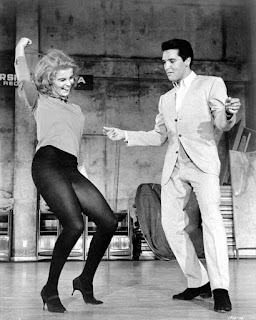The plot is simple enough. Lucky Jackson (Elvis) goes to Las Vegas, Nevada to participate in the city's first annual Grand Prix Race. However, his race car, an Elva Mk. VI, is in need of a new motor (engine) in order to compete in the event. Lucky raises the necessary money in Las Vegas, but he loses it when he is shoved into the pool by the hotel's nubile swimming instructor, Rusty Martin (Ann-Margret). Lucky then has to work as a waiter at the hotel to replace the lost money to pay his hotel bill, as well as enter the hotel's talent contest in hopes of winning a cash prize sizable enough to pay for his car's engine. During all this time, Lucky attempts to win the affections of Rusty. His main competition arrives in the form of Count Elmo Mancini (Cesare Danova), who attempts to win both the Grand Prix and the affections of Rusty. Rusty soon falls in love with Lucky, and immediately tries to change him into what she wants.
In Great Britain, both the movie and its soundtrack were sold as Love In Las Vegas, since there was another, different movie called Viva Las Vegas that was being shown in British cinemas at the same time that Presley's was released.
The chemistry between the two stars was quite real during the filming of Viva Las Vegas. Presley and Ann-Margret began an affair, and this received considerable attention from movie and music gossip columnists. This reportedly led to a showdown with Presley's worried girlfriend Priscilla Beaulieu. (Elvis and Priscilla married in 1967.) In her 1985 book Elvis and Me, Priscilla Presley describes the difficulties that she experienced when the gossip columnists erroneously "announced" that Ann-Margret and Presley had become engaged to be married.
In her memoirs, Ann-Margret refers to Elvis Presley as her "soulmate" and stated: "We felt there was a need in 'The Industry' for a female Elvis Presley."
In addition, the filming of Viva Las Vegas reportedly produced unusually heated exchanges between the director, film veteran George Sidney, and Presley's manager, Colonel Tom Parker, who was not credited as a "Technical Advisor" in the film's credits.
The arguments reportedly concerned the amount of time and effort allotted by the cinematographer, Joseph Biroc, to the song and dance numbers that featured Ann-Margret, ostensibly on the orders of the director. These scenes in Viva Las Vegas include views of Ann-Margret's dancing taken from many different camera angles, the use of multiple movie cameras for each scene, and several retakes of each of her song-and-dance scenes. Despite the arguments behind the scenes, the film marked the high point of Elvis' film career, and even the kids at the sleepover got into the movie and liked it...
MY RATING: 10 OUT OF 10




The musicals in the early 1960s used to be so perfect. I wish Hollywood could still be able to produce musicals as it did in the old times.
ReplyDelete